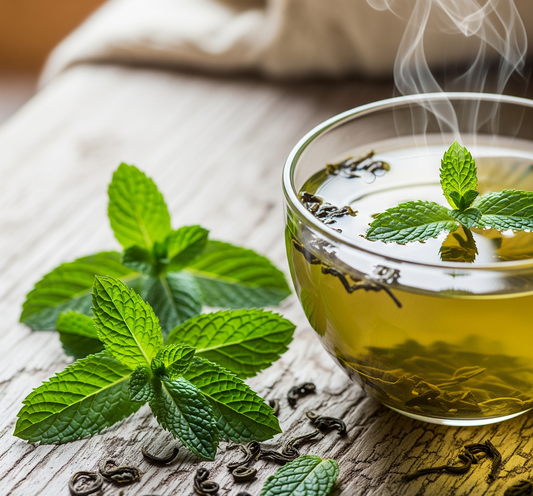Explore the enchanting world of spring tea harvests, where cultures celebrate rebirth and rejuvenation. Discover unique flavors and rituals from Nepal, Japan, Vietnam, China, and India that enrich this cherished season.
Spring tea harvests are celebrated worldwide, akin to New Year's Day, symbolizing rebirth and rejuvenation. This season brings fresh tea buds and a sense of hope, making the delicate flavors and aromas of these teas even more cherished. In Nepal, the First Flush awakens tea bushes in the Himalayan gardens, creating a spectacular sight. The rituals surrounding this harvest enhance its significance, infusing the teas with rich cultural history and lore. Join us as we explore the enchanting myths and magic of spring teas from around the globe!
Spring Tea Harvest in Nepal: Nepali First Flush
 The spring tea harvest in Nepal holds great cultural significance. Winters on the Nepali highlands cover the tea slopes with snowy mists and rains from the Himalayas. During these cold months, tea enters complete dormancy, producing leaves very slowly and storing nutrients in the roots. Tea production comes to a standstill, and the tea communities, with great anticipation, await springtime.
The spring tea harvest in Nepal holds great cultural significance. Winters on the Nepali highlands cover the tea slopes with snowy mists and rains from the Himalayas. During these cold months, tea enters complete dormancy, producing leaves very slowly and storing nutrients in the roots. Tea production comes to a standstill, and the tea communities, with great anticipation, await springtime.
Evaporating mists, blooming magnolias, and scarlet rhododendrons signal the end of winter in Nepal’s tea mountains – but it isn’t until gentle spring showers feed the roots of the tea bushes, allowing new shoots to grow, that we can say that the first flush has truly arrived.
As the young buds open up, Nepali astrologers chart the skies in search of the most auspicious time for the very first pluck of the season, a ritual called “Sahit Juraune” in Nepali. The day and even the hour, down to the minute, of the first pluck of Nepal’s First Flush, relies on the alignment of the heavens. It is crucial that plucking begins on this day, exactly at this hour, preceded by a prayer ceremony for renewal and prosperity throughout the entire year.
This is why tea communities in Nepal say that our First Flush has been blessed by the gods, bringing good fortune to tea farms and to anyone who drinks the tea brewed from fresh buds and leaves. While we can’t say for sure that the Gods might enter your life with blessings as you take a sip of Nepal’s first flush tea, the incredibly delicate flavors and heady aromas will certainly make you feel like they have!
Also read: All about Nepali First Flush Tea: Fresh Blossoms of the Himalayan Spring-Time
Spring Tea Harvest In Japan: Ichibancha

One of the most renowned spring teas in the world is the Sincha or Sencha, which translates from Japanese to “New Tea”. Sencha is Japan’s first harvest, or ‘flush’, also referred to as “Ichibancha”.
Though Ichibancha is Japan’s spring harvest, plucking doesn’t begin as soon as Spring sets in. Farmers and pluckers bide their time, waiting for the ‘Hachiju Hachiya’, or the ‘88th Night of Spring’. The 88th Night of Spring marks the New Year in Japan’s traditional lunar calendar, and so the myth goes that plucking fresh buds on this ancient New Year’s Day blesses the tea gardens, bringing in good fortune for the rest of the year.
Traditionally, this first harvest in Japan falls on May 1st or May 2nd, when tea bushes start to bloom. Legend says that drinking tea from the buds plucked on the 88th night can protect the drinker from ailments like paralysis. In certain tea-making prefectures, there are sayings claiming that even being touched by a wind that blows through the Sincha tea markets can protect you from sickness all year long! According to an article on Japanese Green Tea, first-flush Japanese teas like Sencha and Matcha are rich in antioxidants that aid in combating stress, remove harmful molecules in the body, and support overall cell health, leading to a healthy body and mind.
Well, whether or not Sincha can shield you from illness all year long, this fresh and vibrant Spring tea can certainly imbue a rejuvenating and uplifting energy onto the drinker – and all you have to do is enjoy the brew every day!
Spring Tea Harvest in Vietnam: Wild Tea Snow Shan
 Another amazing spring tea flavors is Vietnamese spring tea. Vietnam has one of the world’s most fascinating tea traditions, with a tea history going back over 4000 years. Vietnam is known for its premium Pu'er and green teas crafted from the leaves of ancient, heirloom tea trees. Among them, Lotus tea is a local signature that is enriched by centuries of fine artisanship and fascinating lore.
Another amazing spring tea flavors is Vietnamese spring tea. Vietnam has one of the world’s most fascinating tea traditions, with a tea history going back over 4000 years. Vietnam is known for its premium Pu'er and green teas crafted from the leaves of ancient, heirloom tea trees. Among them, Lotus tea is a local signature that is enriched by centuries of fine artisanship and fascinating lore.
The practice of harvesting spring rains for the first steep of tea shared with friends, neighbors, and family is still prevalent in Vietnam, but ancient nobility took it a step further. According to an article on Vietnam Agriculture, peasants would rise at 4 a.m. to harvest every drop of dew stored in the buds of lotus flowers to steep a fresh cup of tea for the King -- no other kind of water was acceptable for the King!
For commoners like us, the crafting of Lotus teas is not quite so meticulous. But it is a delicate process nonetheless. In the Spring, local tea makers scale the towering wild Snow Shan trees, plucking a Spring Tea harvest of white, soft, and delicate tea leaves. Also known as ancient tea, these leaves have a gentle floral flavor profile with notes of honey. These leaves make up the base of the Lotus tea. In the Summer, when the lotus flowers are in full bloom, farmers row out to pluck the flowers and infuse their aroma into the made tea leaves.
And though only a couple of centuries have passed since farmers harvested dew to brew teas for their Kings, farmers still do row out at 4 a.m. – when the fragrance of the lotus is said to be at its peak – to harvest only the best lotus blooms to scent their teas with.
Spring Tea Harvest in China: The Qing Ming Festival

The start of the Spring tea harvest in China is marked by the Qing Ming Je, also known to us as the Tomb Sweeping Festival. As the name suggests, people celebrate the day by cleaning/sweeping the tombs of their ancestors and deceased loved ones, leaving behind offerings of incense and flowers.
While this day of honoring one’s ancestors might not seem to have a direct link to China’s Spring tea harvest, this holiday does mark the beginning of springtime in China. Over the centuries, the festival and the Chinese Spring tea harvests have become inextricably linked. Some of the most precious teas from China, like Zhejiang Province’s Long Jing green teas, are harvested during and after the Qing Ming Je.
Regarded as some of the most precious tea leaves in the world, Chinese Spring harvests can fetch incredible prices. But if you’d like to spend a little extra, and taste the teas that historically only graced the teacups of Kings, you can also try the incredibly tender and gorgeous Pre-Qing Ming harvests!
Spring Tea Harvest in India: The Champagne of Teas
Darjeeling’s First Flush tea is one of the most coveted Spring tea harvests, made all the more enticing by the sheer beauty of the landscapes that house these tea bushes. Darjeeling’s tea farms are located in the Himalayas of West Bengal, and framed by beautiful groves of bamboo and pine.
The Spring harvest season begins in March, with tea masters sometimes relying on Rhododendron blooms to mark this harvest season. Just like most spring harvests, Darjeeling’s Spring harvest comprises the first two leaves and buds of the new shoot. These precious leaves are then crafted to preserve the smooth, floral, and honeyed flavor profile that gives Darjeeling teas their title: the Champagne of Teas.

With that, we wrap up our short tour through the Springtime of the tea world. Every Spring tea harvest is a precious time for tea communities, entwined with tradition and hopes for the future. But the teas that spring from these harvests also showcase the talent of farmers and tea makers, signifying an unflagging pride in their teas and care for the art of tea making.
Every Spring tea is special in its own way – we can attest to that. If you’d like to compare for yourself, we can certainly offer you the best of the Himalayan springtime!
FAQ’s about Nepali First Flush
What is First Flush tea?
First Flush tea refers to the very first plucking of young tea leaves and buds during the spring season. These leaves are delicate, fresh, and packed with nutrients that have been stored during the dormancy of winter, resulting in light, floral, and complex flavors.
Why is Nepal’s First Flush so special?
Nepal’s First Flush is unique due to its high-altitude Himalayan terroir and the traditional “Sahit Juraune” ritual. This involves plucking the leaves at an astrologically auspicious time, which is believed to bless the tea with prosperity and good fortune. The result is an incredibly fragrant and flavorful tea with a rich cultural heritage.
How does First Flush tea differ from Second Flush tea?
First Flush tea is harvested in early spring and is known for its light, floral, and delicate flavor profile. Second Flush tea, harvested later in the summer, has a bolder, fuller body with muscatel notes and a more robust character.
What are the health benefits of First Flush tea?
First Flush tea is rich in antioxidants and polyphenols, which help boost metabolism, support heart health, reduce stress, and improve overall well-being. Its light caffeine content also provides a gentle energy boost without the jitters.
How should First Flush tea be brewed for the best taste?
To fully enjoy the subtle flavors and aromas of First Flush tea, steep the leaves in water heated to around 175°F (80°C) for 3-4 minutes. Using high-quality, filtered water and avoiding over-steeping will enhance the tea’s delicate character.




